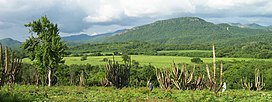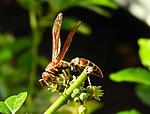
Nayarit, officially the Estado Libre y Soberano de Nayarit, is one of the 31 states that, along with Mexico City, comprise the Federal Entities of Mexico. It is divided in 20 municipalities and its capital city is Tepic.

The Sonoran Desert is a hot desert in North America and ecoregion that covers the northwestern Mexican states of Sonora, Baja California, and Baja California Sur, as well as part of the southwestern United States. It is the hottest desert in both Mexico and the United States. It has an area of 260,000 square kilometers (100,000 sq mi).

The Sierra Madre Occidental is a major mountain range system of the North American Cordillera, that runs northwest–southeast through northwestern and western Mexico, and along the Gulf of California. The Sierra Madre is part of the American Cordillera, a chain of mountain ranges (cordillera) that consist of an almost continuous sequence that form the western "sounds" of North America, Central America, South America, and West Antarctica.
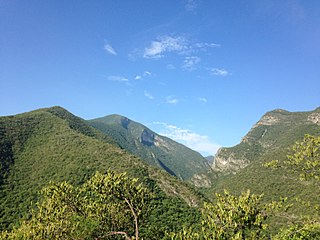
The Sierra Madre Oriental is a mountain range in northeastern Mexico. The Sierra Madre Oriental is part of the American Cordillera, a chain of mountain ranges (cordillera) that consists of an almost continuous sequence of mountain ranges that form the western "backbone" of North America, Central America, South America, and Antarctica.
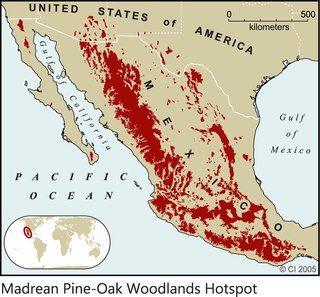
The Madrean pine–oak woodlands are subtropical woodlands found in the mountains of Mexico and the southwestern United States. They are a biogeographic region of the tropical and subtropical coniferous forests and temperate broadleaf and mixed forests biomes, located in North America.

The Sierra Madre Occidental pine–oak forests are a Temperate broadleaf and mixed forests ecoregion of the Sierra Madre Occidental range from the southwest USA region to the western part of Mexico. They are home to a large number of endemic plants and important habitat for wildlife.
The narrow-skulled pocket mouse is a species of rodent in the family Heteromyidae. It is endemic to western Mexico, living west of the Sierra Madre Occidental crest.

The Veracruz moist forests is a tropical moist broadleaf forests ecoregion in eastern Mexico.
Mexican dry forest describes a number of ecoregions of Mexico within the dry broadleaf forest Biome. Together they constitute a World Wildlife Fund Global 200 priority ecoregions area for conservation.

The Balsas dry forests is a tropical dry broadleaf forest ecoregion located in western and central Mexico.

The Central Mexican matorral is an ecoregion of the deserts and xeric shrublands biome of central Mexico. It is the southernmost ecoregion of the Nearctic realm.
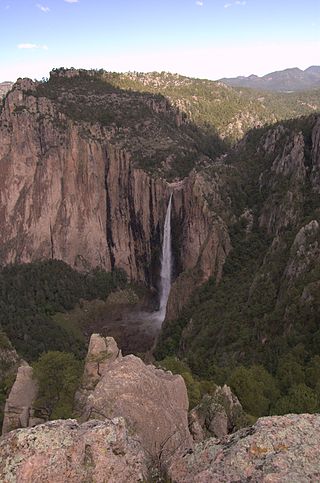
Basaseachic Falls National Park is a national park located in the western side of the state of Chihuahua in the heart of the Sierra Madre Occidental mountain range. The park is named after Basaseachic Falls the second tallest waterfall in Mexico with a height of 246 meters (853 ft). Basaseachic Falls empties into Candameña Canyon which was carved by the Basaseachic River over millions of years. The park is known for its pine-oak forest, rock formations, and scenic views from high cliffs. Cliffs in the park reach an impressive height of 1,640 meters (5,380 ft).

The Sonoran–Sinaloan transition subtropical dry forest is a tropical dry broadleaf forest ecoregion in northwestern Mexico.
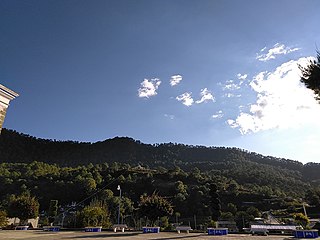
The Sierra Madre del Sur pine–oak forests is a subtropical coniferous forest ecoregion in the Sierra Madre del Sur mountain range of southern Mexico.

The Chiapas Depression dry forests form one of the ecoregions that belong to the tropical and subtropical dry broadleaf forests biome, as defined by the World Wildlife Fund, in northwestern Central America.

The Jalisco dry forests is a tropical dry broadleaf forest ecoregion in southwestern Mexico.

The Southern Pacific dry forests is a tropical dry broadleaf forest ecoregion in southern Mexico.

The Sierra de Álamos–Río Cuchujaqui Flora and Fauna Protection Area, also known as the Sierra de Álamos–Río Cuchujaqui Biosphere Reserve, is a protected area and biosphere reserve in western Mexico. It is located in southeastern Sonora state, along the boundary with Sinaloa and Chihuahua states.

The Sierra de San Juan Biosphere Reserve is a protected area in Nayarit state of western Mexico. It was established in 2003, and has an area of 198.01 km2. It lies just southwest of the city of Tepic. It protects a portion of the Sierra de San Juan, a mountain range which lies between Tepic and the Pacific Ocean.

The Espinazo del Diablo is a region of the Sierra Madre Occidental in the states of Sinaloa and Durango in northwestern Mexico. The region is known its natural beauty and biodiversity, including rare cloud forests, and for a stretch tortuous mountain highway also called the Espinazo del Diablo.
